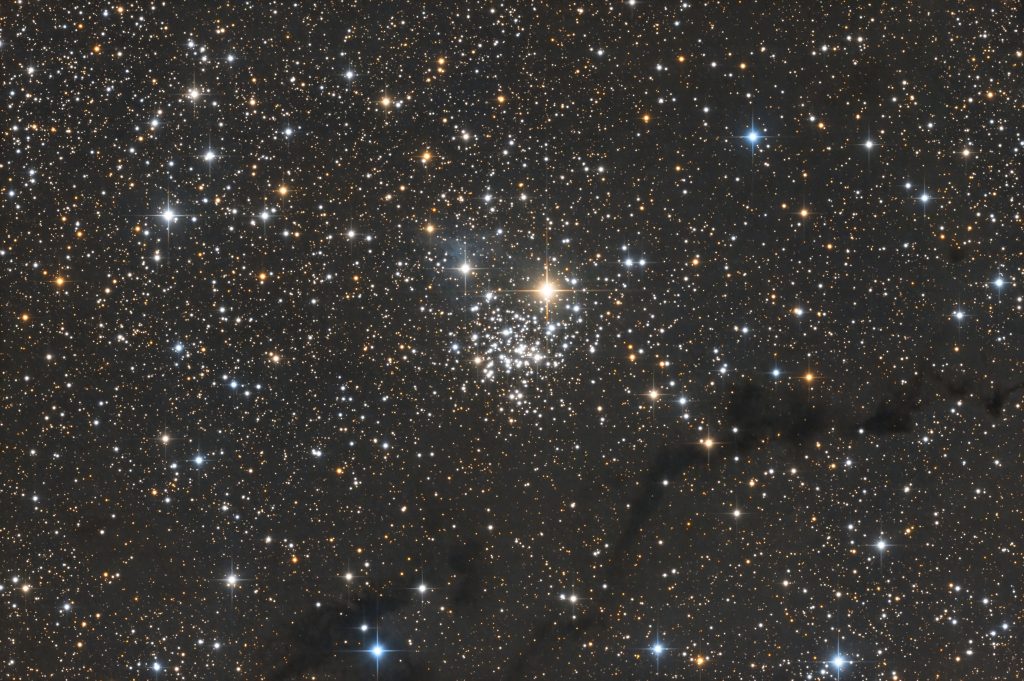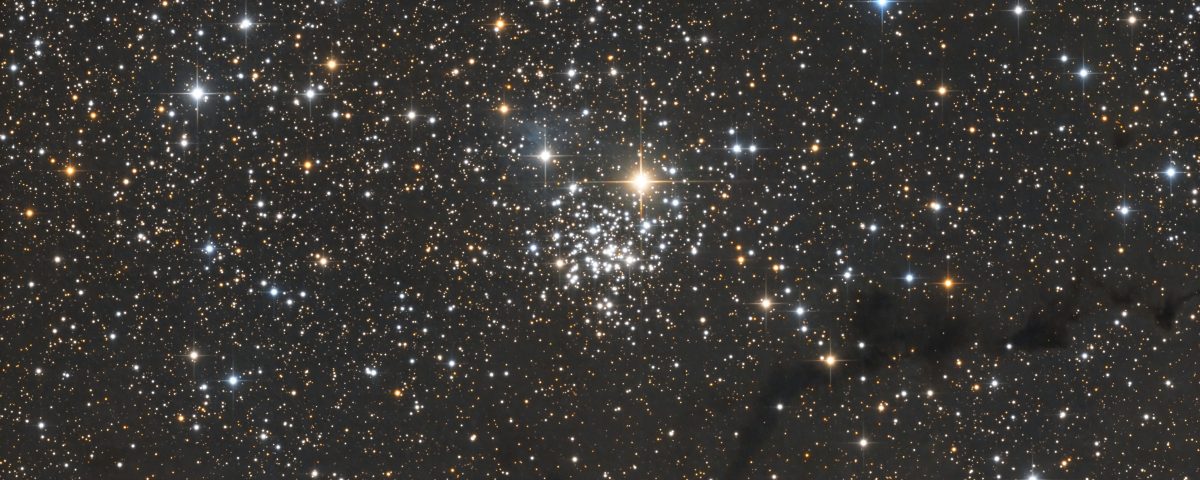NGC 654 de Bogdan Stanciu

A patra ședință a cursului nostru de astronomie de Tiberiu Savin
noiembrie 13, 2025
Călătoria Emiratelor Arabe Unite în Spațiu
noiembrie 23, 2025Data publicării: 23 noiembrie 2025
RO (for English scroll down)
NGC 654 este unul dintre numeroasele roiuri deschise găsite în bogatul plan galactic care traversează constelația Cassiopeia. Conturul roiului seamănă cu asterismul „Ceainicul” al Săgetătorului, cu stelele sale mai strălucitoare de-a lungul sudului său formând mânerul. De departe, cea mai strălucitoare stea din roi este supergiganta luminoasă de tip spectral F, HD 10494, cu magnitudinea 7. În total, NGC 654 conține 83 de stele, majoritatea fiind de tip spectral B.
Steaua identificată ca HIP 8074 plutește nu departe de corpul principal al roiului și s-a stabilit că nu este membră a NGC 654. Cu toate acestea, această stea gigantică de tip A atrage atenția prin nebuloasa sa de reflexie albăstruie – vdB 6 – o amintire a nebulozității care înconjoară Pleiadele. În imagini mai profunde, se poate observa și un gol în fundalul înstelat care șerpuiește de la E la V, aproape la nord de roi. Aceasta este o nebuloasă întunecată compusă din 3 obiecte LDN (1332, 1334, 1337), ceea ce sporește complexitatea regiunii.
NGC 654 este membră a asociației Cas OB8 din brațul spiralat Perseus al Căii Lactee. La fel ca roiurile deschise vecine, există nori moleculari și regiuni prăfuite în fața roiului, care îl înroșesc cu până la 1,1 magnitudini. Observațiile polarimetrice au detectat două straturi principale de praf – unul la 650 de ani-lumină și celălalt la 3300 de ani-lumină – care blochează o parte din lumina roiului, situat mult dincolo de ele, la 7800 de ani-lumină.
Un alt fapt interesant despre roi este că doi dintre membrii săi au fost ejectați acum milioane de ani. HD 14633 (mag. +7,4) se găsește acum în Andromeda și este o binară spectroscopică de tip spectral O8.5. HD 15137 (mag. +7,8) se găsește în Perseus și este o gigantă luminoasă de tip spectral O9.5, dar și o binară spectroscopică. Ambele stele însoțitoare par a fi stele neutronice de masă mică. Traiectoriile și vitezele lor arată că au fost ejectate prin explozii asimetrice de supernove.
Expunere totală: 7h50 RGB
Telescop: Planewave CDK 17” f/6,8 – Hellas Sky
Camera: QHY600Pro-M
Procesare: PixInsight
Autor text si foto: Bogdan Stanciu
EN
NGC 654 is one of the many open clusters found in the rich galactic plane crossing the constellation of Cassiopeia. The cluster’s outline resembles the “teapot” asterism if Sagittarius, with its brighter stars along its south forming the handle. By far the brightest star in the cluster is the magnitude 7 F-type luminous supergiant HD 10494. In total, NGC 654 contains 83 stars, most of them being B-type.
The star identified as HIP 8074 floats not far from the main body of the cluster and it has been determined that it’s not a member of NGC 654. However, this A-type giant star attracts attention by its bluish reflection nebula – vdB 6 – a reminder of the nebulosity surrounding the Pleiades. In deeper images, one may also discern a void in the starry background meandering from E to W, almost north of the cluster. This is a dark nebula composed of 3 LDN objects (1332, 1334, 1337) which adds to the complexity of the region.
NGC 654 is a member of the Cas OB8 association in the Perseus spiral arm of the Milky Way. Like its neighboring open clusters, there are molecular clouds and dusty regions in front of the cluster, reddening it by up to 1,1 magnitudes. Polarimetric observations detected two main dust layers – one at 650 light-years and the other at 3300 light-years – that block some of the cluster’s light, located far beyond them, at 7800 light-years.
Another interesting fact about the cluster is that two of its members have been ejected millions of years ago. HD 14633 (mag. +7,4) is now found in Andromeda and it’s a O8.5 spectroscopic binary. HD 15137 (mag. +7,8) can be found in Perseus and it’s a 09.5 luminous giant and also a spectroscopic binary. Both stars companions seem to be low mas neutron stars. Thei trajectories and speeds show that they were ejected via asymmetric supernova explosions.
Exposure time: 7h50’ RGB
Telescope: Planewave CDK 17” f/6,8 – Hellas Sky
Camera: QHY600Pro-M
Processing: PixInsight
Author text and photo: Bogdan Stanciu




